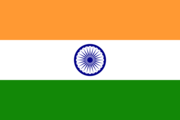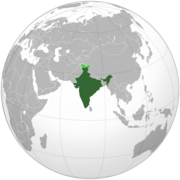Social:Indian Century
| India | |||
|---|---|---|---|
 | |||
 |
The Indian Century[1][2] is a neologism suggesting that the 21st century will be dominated by India , as the 20th century is often called the American Century,[3] and the 19th century as Pax Britannica (British Peace),[4] as the 17-18th centuries dominated by France and the 15-16th centuries dominated by Spain.[5][6] The phrase is used particularly in the assertion that the economy of India could overtake[7][8] the economy of the United States and economy of China as the largest national economy in the world,[9] a position it held[10] from 1 to 1500 CE and from 1600 to 1700 CE.[11][12]
Debates and factors
According to the report named "Indian Century: Defining India's Place in a Rapidly Changing Global Economy" by IBM Institute for Business Value, India is predicted to be among the world's highest-growth nations over the coming years.[13][14][15]
As per a report released by Federation of Indian Chambers of Commerce & Industry (FICCI) and McKinsey & Company titled "India’s Century – Achieving sustainable, inclusive growth", India has the potential to become an "economic superpower" before its 100th year of Independence (2047).[16][17]
India is a member of Build Back Better World and has also created North–South Transport Corridor as an alternative to the Belt and Road Initiative policy initiative of China (PRC),[18][19][20] to link in with Iran, Russia, the Caucasus, and Central Asia. In 2017, India and Japan[21][22] joined together to form Asia-Africa Growth Corridor, to better integrate the economies of South, Southeast, and East Asia with Oceania and Africa.[21][22] India also engages in Quadrilateral Security Dialogue and Malabar (naval exercise) for China containment policy.
| <timeline>
ImageSize = width:auto height:250 barincrement:50 PlotArea = left:50 bottom:15 top:10 right:50 AlignBars = justify TimeAxis = orientation:vertical DateFormat = x.y Period = from:0.0 till:750 ScaleMajor = unit:day start:0.0 increment:50 BarData= bar:US text: US bar:CN text: China bar:IN text: India bar:RU text: Russia bar:SA text:S. Arabia PlotData= color:blue width:25 bar:US from:start till:732.0 bar:CN from:start till:261.0 bar:IN from:start till:71.0 bar:RU from:start till:65.1 bar:SA from:start till:61.9 TextData = pos:(0,0) text:US$ bn </timeline> |
| Top five countries by military expenditure in 2016. According to the Stockholm International Peace Research Institute.[23] |
One of the key factors includes its populous democracy.[24][25] As per United Nations report, India will overtake China to become the world's most populous nation by 2022.[26][27]
Economists and researchers at Harvard University have projected India's 7% projected annual growth rate through 2024 will continue to put it ahead of China, making India the fastest growing major economy in the world.[28][29] In 2017, the Center for International Development at Harvard University published a research study[30] projecting that India has emerged[30] as the economic pole of global growth by surpassing China and is expected to maintain its lead over the coming decade.[30]
India is very recently being considered a major great power or emerging so (well beyond middle powers) and generally considered an emerging superpower due to its large and stable population and its rapidly growing economic and military sectors.[31]
See also
References
- ↑ Nayan Chanda; Clyde Prestowitz (3 December 2012). A World Connected. Yale University Press. ISBN 978-0977992201. https://books.google.com/books?id=a_Xhxv5YDjkC&pg=PA19.
- ↑ Martin Halliwell; Catherine Morley (2008). American Thought and Culture in the 21st Century. Oxford University Press. p. 10. ISBN 9780748626021. https://books.google.com/books?id=l2k5zrO23aAC&pg=PA10.
- ↑ "21st century is going to be Indian century: Alagappan". 1 December 2007. http://news.oneindia.in/2007/12/01/21st-century-is-going-to-be-indian-century-alagappan-1196517764.html.
- ↑ Halliwell, Martin; Catherine Morley (2008). American Thought and Culture in the 21st Century. Edinburgh University Press. pp. 9–10. ISBN 978-0748626021.
- ↑ Aldrich, Robert (1996). Greater France: A History of French Overseas Expansion. p. 304.
- ↑ Page, Melvin E., ed (2003). Colonialism: An International Social, Cultural, and Political Encyclopedia. ABC-CLIO. p. 218. ISBN 9781576073353. https://books.google.com/books?id=qFTHBoRvQbsC&pg=PA218.
- ↑ "The West and the Rest in the International Economic Order". Organisation for Economic Co-operation and Development. http://oecdobserver.org/news/archivestory.php/aid/884/The_West_and_the_Rest_in_the_International_Economic_Order.html.
- ↑ "China, India to Overtake U.S. Economy by 2050". U.S. News & World Report. https://www.usnews.com/news/articles/2017-02-07/china-india-to-overtake-us-economy-by-2050.
- ↑ "Of Oxford, economics, empire, and freedom". The Hindu (Chennai). 2 October 2005. http://www.hindu.com/2005/07/10/stories/2005071002301000.htm.
- ↑ An Era of Darkness: The British Empire in India. Aleph Book Company. 2016. ISBN 978-9383064656.
- ↑ "ADFQtcg.png". http://glavkonstruktor.ru/upload/img/ADFQtcg.png.
- ↑ Data Source: Tables of Prof. Angus Maddison (2010). The per capita GDP over various years and population data can be downloaded in a spreadsheet from here.
- ↑ Banda, Madhuri; Patrao, Clifford; Marshall, Anthony. "Indian Century - Defining India's place in a rapidly changing global economy". Institute for Business Value. https://www.ibm.com/thought-leadership/institute-business-value/report/indiancentury.
- ↑ Team, BS Web (10 December 2015). "India to be world's highest growth nation in 21st century: IBM study". Business Standard. http://www.business-standard.com/article/economy-policy/india-to-be-world-s-highest-growth-nation-in-21st-century-ibm-study-115121000918_1.html.
- ↑ "21st century is India's century: IBM chief Virginia Rometty". Moneycontrol.com. 14 July 2015. http://www.moneycontrol.com/news/economy/21st-century-is-indias-century-ibm-chief-virginia-rometty_1963021.html.
- ↑ Anand, Saurav (2022-12-16). "FICCI, McKinsey lays down roadmap to achieve ₹10 L per capita income by 2047" (in en). https://www.livemint.com/economy/ficci-mckinsey-lays-down-roadmap-to-achieve-rs-10-lakh-per-capita-income-by-2047-11671201066920.html.
- ↑ "India's Century – Achieving sustainable, inclusive growth". FICCI; McKinsey & Company. December 2022. https://india-century.com/reports/report.pdf.
- ↑ "India ratifies TIR Convention to access transnational multi-modal connectivity". Mint. 19 June 2017. http://www.livemint.com/Politics/dqvNmMJGbqQAC8pYZPAYdI/India-ratifies-TIR-Convention-to-access-transnational-multi.html.
- ↑ "Watch Out, China: India Is Building A 'New Silk Road' Of Its Own". Forbes. https://www.forbes.com/sites/wadeshepard/2017/06/28/watch-out-china-india-is-building-a-new-silk-road-of-its-own/#515c8a5a90ec.
- ↑ "PM Modi in Russia: How fastracking North-South corridor will help India counter Chinese OBOR". The Financial Express (India). June 2017. http://www.financialexpress.com/india-news/pm-modi-in-russia-how-fastracking-north-south-corridor-will-help-india-counter-chinese-obor/696639/.
- ↑ 21.0 21.1 "India And Japan Join Forces To Counter China And Build Their Own New Silk Road". Forbes. https://www.forbes.com/sites/wadeshepard/2017/07/31/india-and-japan-join-forces-to-counter-china-and-build-their-own-new-silk-road/#2fb1ae0b4982.
- ↑ 22.0 22.1 "Ignoring OBOR, India and Japan forge ahead with joint connectivity project". The Economic Times. http://economictimes.indiatimes.com/news/politics-and-nation/ignoring-obor-india-and-japan-forge-ahead-with-joint-connectivity-project/articleshow/59830218.cms.
- ↑ "Trends in World Military Expenditure, 2019". Stockholm International Peace Research Institute. https://www.sipri.org/sites/default/files/2020-04/fs_2020_04_milex_0_0.pdf.
- ↑ "'India’s decade could pave way for an Indian century'." Hindustan Times.
- ↑ "Next century will be India's, says WSJ". Oman Tribune. http://www.omantribune.com/index.php?page=news&id=61484&heading=India.
- ↑ "India 'to overtake China's population by 2022' - UN". BBC. 30 July 2015. https://www.bbc.com/news/world-asia-33720723.
- ↑ "World Population Prospects 2017 - UN". United Nations. https://esa.un.org/unpd/wpp/.
- ↑ "New Growth Projections Predict the Rise of India, East Africa and Fall of Oil Economies". 7 May 2015. http://www.hks.harvard.edu/news-events/news/articles/new-growth-projections.
- ↑ "India Will Be Fastest-Growing Economy for Coming Decade, Harvard Researchers Predict". 1 January 2016. https://blogs.wsj.com/indiarealtime/2016/01/01/india-will-be-fastest-growing-economy-for-coming-decade-harvard-researchers-predict/.
- ↑ 30.0 30.1 30.2 "New 2025 Global Growth Projections Predict China's Further Slowdown and the Continued Rise of India". Harvard University. http://atlas.cid.harvard.edu/rankings/growth-predictions/.
- ↑ Lydon, Christopher (6 August 2010). "Real India: A Historian's Cautions on "The Indian Century" (AUDIO)". Huffington Post. https://www.huffingtonpost.com/christopher-lydon/real-india-a-historians-c_b_673262.html.
Further reading
- "Is this the Indian century?" The Guardian.
- China's Century — or India's? Time
- India, China to become superpowers in two decades The Economic Times.
- China and India: The Power of Two Harvard Business Review
- "Lesson From Old India" The New York Times
- Dirks, Nicholas (2008) The Scandal of Empire: India and the Creation of Imperial Britain. Belknap Press ISBN:978-0-674-02724-4.
- Durant, Will (1930) The Case for India. New York: Simon and Schuster.
- Gupte, Pranay (29 December 2013). "The Indian Century, great war to 2014". Deccan Chronicle. https://www.deccanchronicle.com/131229/commentary-sunday-chronicle/article/indian-century-great-war-2014.
- Kennedy, Paul (1989) The Rise and Fall of the Great Powers. Vintage. ISBN:978-0-679-72019-5.
- Lak, Daniel (2009) India Express: The Future of the New Superpower. Palgrave Macmillan ISBN:0-230-61759-X.
- Luce, Edward (2008) In Spite of the Gods: The Rise of Modern India. Anchor ISBN:978-1-4000-7977-3.
- Marks, Robert (2007) The Origins of the Modern World: A Global and Ecological Narrative from the Fifteenth to the Twenty-first Century. Rowman & Littlefield Publishers ISBN:978-0-7425-5419-1.
- McKinsey & Company Inc. (2013) Reimagining India: Unlocking the Potential of Asia's Next Superpower. Simon & Schuster ISBN:978-1-4767-3530-6.
- Meredith, Robyn (2008) The Elephant and the Dragon: The Rise of India and China and What It Means for All of Us. W. W. Norton & Company ISBN:978-0-393-33193-6.
- Parthasarathi, Prasannan (2011) Why Europe Grew Rich and Asia Did Not : Global Economic Divergence, 1600–1850. Cambridge University Press ISBN:978-0-521-16824-3.
- Rothermund, Dietmar (2008) India: The Rise of an Asian Giant. Yale University Press ISBN:978-0-300-11309-9
- Sieff, Martin (2010) Shifting Superpowers: The New and Emerging Relationships between the United States, China and India. Cato Institute ISBN:978-1-935308-21-8.
- Smith, Jeff (2013) Cold Peace: China-India Rivalry in the Twenty-First Century. Lexington Books ISBN:978-0-7391-8278-9.
- Tharoor, Shashi (2012) Pax Indica: India and the World of the Twenty-First Century. Penguin Global ISBN:978-0-670-08574-3.
External links
- Infographic: Share of world GDP throughout history | Infogram
- How the British Ruined India
- "India will be the biggest superpower". http://www.rediff.com/money/2006/mar/29minter.htm.
 |
